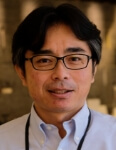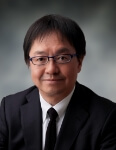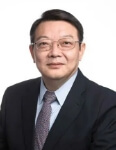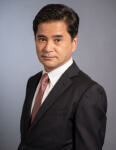
Keynote Lectures
 Evolution and Innovation of Silicon Island Kyushu (in Japanese)
Evolution and Innovation of Silicon Island Kyushu (in Japanese)Hideyuki Okano
Kyushu Economic Research Center
Abstract:
The tide surrounding the recent semiconductor industry has changed dramatically due to the development of a digital society and carbon neutrality, as well as discussions on economic security. While Moore's Law is approaching its limit, 3DIC (heterogeneous integration) such as gchipleth is attracting attention, and technological structural changes are also taking place. In Japan, the Ministry of Economy, Trade and Industry (METI) formulated the "Semiconductor and Digital Industry Strategy" in June 2021, and an industrial policy that positions the semiconductor industry as the most important industry for economic security has begun to be deployed.
Against this backdrop, the location of TSMC has served as an opportunity for Kyushu to take advantage of the potential of its existing industrial and technological agglomeration, while promoting various initiatives that match the government's policies.
More than 1,000 semiconductor-related companies are located in Kyushu, and it is called gSilicon Islandh. Kyushu's strength lies in the formation of a local supply chain led by global device companies such as Sony and Renesas Technology, as well as its global supply chain that supplies the world market. In addition to materials, manufacturing equipment, and design companies, there is also a concentration of user companies such as robots and automobiles. Furthermore, Kumamoto University, Kyushu University, Kyushu Institute of Technology, and Waseda University are focusing on research and development of semiconductors. Research support organizations such as the Kyushu Center of the National Institute of Advanced Industrial Science and Technology (AIST), Fukuoka Institute of System LSI Design Industry, and Research Center for 3D Semiconductors have advanced package prototype development lines and minimal fab package lines. It is used by companies and researchers in a wide range of business areas nationwide.
Local medium-sized companies are also growing their businesses and enhancing their R&D and business construction capabilities. We have broken away from the single-track subcontracting management and are doing strong management with double-track portfolio management.
This lecture introduces the genealogy and innovation of the evolution of Silicon Island Kyushu, which has one of Japan's leading semiconductor industry clusters.
 Connected Smart EVs save the World
Connected Smart EVs save the WorldTsuguo Nobe
Nagoya University
Abstract:
Since the early 1970s, soon after semiconductors were put to commercial use, microprocessor-based ECUs (Electric Control Units) such, as ABS (Anti-Brake Locking Systems), have played a major role for the better environment, safety, and comfort of automobiles.
In the early 2000s, car navigation systems, which became popular especially in Japan, were connected to so-called gGalapagos cell phonesh, which were the first in the world to enable Internet connectivity, uploading car status and location data to Data Centers and providing dynamic traffic jam information and simple driving assistances. This is truly the Vehicle IoT with connected cars. After 2010, the international proliferation of smartphones and the formation of the Cloud have allowed connected car solutions to spread around the world.
Around after mid-2010s, cars were equipped with sensors such as cameras, radar, and ultrasonic waves in to recognize the external environment more accurately, and the sophistication of ECU made cars even smarter, allowing them to upload data on driving conditions and the external environment to feed for deep learning. In many cases, deep learning can be applied to generate driving algorithms to understand " how a car should be driven in this situationh. This has led to the expansion of "advanced driving supporth.
Furthermore, by connecting various transportation services to the Cloud, gdigital twinh of the real-world can be formed in the Cloud, resulting the service of transportation to suggest faster, cheaper, and more comfortable trips. This is the initial phase of MaaS.
By 2025, to provide such advanced driving assistant services and MaaS, cars need to be equipped with around 400W of computational power, which will require EVs with 60-100KWh of batteries. EVs with that much battery capacity will be incorporated as a mobile storage to stabilize the power supply in the coming renewable-energy society. Toward the age of carbon neutrality, these "connected smart cars" will, thus, save the earth and human beings.
 History, Achievement, Challenge, and Future Trend of IC Packaging Industry in China
History, Achievement, Challenge, and Future Trend of IC Packaging Industry in ChinaTianchun Ye
Institute of Microelectronics of the Chinese Academy of Sciences
Abstract:
For the past decades, the semiconductor industry has consistently followed Moorefs Law, which boost the compute power to the next level in approximately every two years. However, with the decelerate of the fabrication node evolvement, the Advanced Packaging technology, which also interpreted as eMore than Mooref approach, has started to demonstrate the potential of extending the lifespan of the Moorefs Law. Advanced Packaging targets in integrating the transistors or chips not only in horizontal, but mostly importantly, in vertical, thus forms a new type of semiconductor chip that accommodates much higher transistor density, which enables huge compute power leap as the stack goes beyond a single layer. Meanwhile, as the density of computer power largely enhanced, the subsidiary technologies like power supply and thermal management needs to be innovated as well.
The OSATs in China are looking at the opportunity of expanding their business, and has been actively involved in defining the high-end IC products with the assist of advanced packaging along with the users. Based on the ideology that the R&D of industrial generic technology is the major and necessary means for the technologic rivalry before their entering to the competition, while aiming at the rapid growth of demands of these products in China, National Center for Advanced Packaging Co., Ltd., along with other newly founded centers have been established to try to give an answer to Chinafs IC industry based on the readiness of the highly demanding technology. This presentation will look back in the IC packaging industry in China and the significant dedication to rank among the best companies in the world nowadays and introduce the current endeavor in the advanced packaging to solve the Chinafs current industry dilemma. Last but not least, the presentation will also share a view of the future course of advanced packaging development.
 Semiconductor Market Outlook and TSMC introduction
Semiconductor Market Outlook and TSMC introductionMakoto Onodera
TSMC Japan
Abstract:
The proliferation of 5G and AI applications are driving explosive data growth. The result is unprecedented demand for higher computing power and greater need for energy efficient computing in edge devices, cloud datacenters and networking infrastructures.
Continuous innovation in semiconductor technologies, including geometry scaling, specialty technologies and 3D chip stacking and packing, will unleash more potential for the next-wave digital transformation.
The dedicated foundry model has made significant contributions to unleash and speed up IC innovation that has nearly transformed in various aspects. TSMC has been at the forefront of this transformation and expanding global manufacturing and R&D footprint to support customersf business growth.

